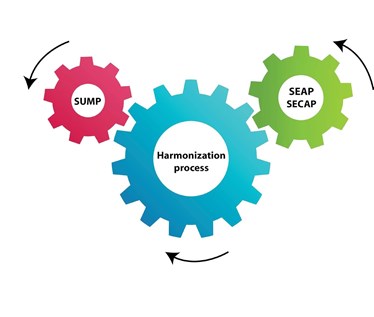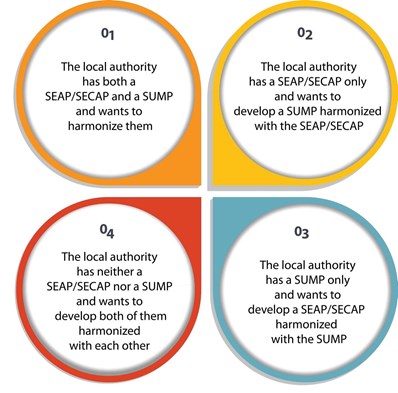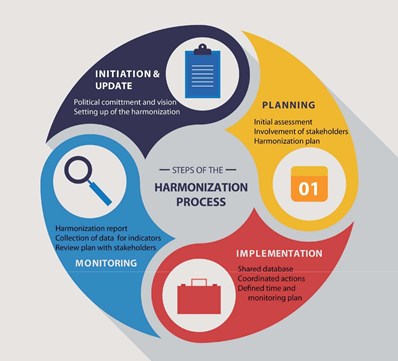The differences between SECAPs and SUMPs highlighted in the previous paragraph should not lead the reader to the conclusion that their harmonization is not viable. Harmonizing, furthermore, does not mean unification of activities or the mere inclusion of sections of one plan into the other.
Harmonization means working on those areas which are complementary in order to have the plans working together for the achievement of an overall strategic objective. Harmonization helps different departments in local authorities share the same vision, work together and optimize the use of resources.
Figure 1 illustrates the idea of harmonizing the activities of a SECAP and a SUMP into one single framework by the analogy of meshed gears.

Fig 1: Harmonized framework for action
Note: Making an analogy between a gearing system and the harmonized development and implementation of SECAP and SUMP, we could come up with two considerations:
- the lack of activity in one of two plans or in their harmonization forcedly stops the other two;
- once started, the wheel representing the harmonization process, showing an inertia and a diameter far more significant than the other two, easily drags the smaller wheels representing the SECAP and the SUMP.
The areas of potential cooperation to focus on during the harmonization process are the following:
- Strategic vision: both SUMPs and SECAPs (in particular considering the new elements added by SECAPs) aim at improving citizens’ quality of life and minimizing impacts on the environment.
- Baseline: all plans rely on a thorough definition of the baseline against which the progress in achieving the plans’ objectives is to be measured. Defining common databases leads to more coherence and a more efficient use of resources.
- Participation of stakeholders: the successful development of both upona SECAP and a SUMP depends upon the active involvement of stakeholders. A coordinated management of the stakeholders’ involvement process helps in the definition of a single vision and a better use of resources.
- Common actions: all actions related to low carbon mobility actions contribute to the achievement of the goals of both plans, by targeting improved mobility and energy efficiency or renewable energy. Therefore for the development of coordinated actions is crucial.
- Monitoring and controlling: Checking progress towards the goals is common to SECAPs and SUMPS, as well as the identification of new challenges, so both plans should be monitored and controlled in a harmonized way.
Local authorities initiating their harmonization process may have different starting scenarios:
- They may already have both a SECAP and a SUMP, needing harmonization;
- They may already have either a SECAP or a SUMP, needing to develop the other in such a way that it is harmonized with the existing plan;
- They may have to develop both plans.
Possible starting scenarios are shown in Figure 2:

Fig 2: Starting scenarios for the harmonization process
In terms of management, four operational principles should guide the harmonization process:
- Shared vision: all departments taking part in the process (mobility, environment, energy, land use planning etc.)
should share the same vision and strategic objective. - Cooperation: all departments taking part in the process (mobility, environment, energy, land use planning etc.) should work jointly and actively cooperate.
- Leadership: a single, qualified and capable project manager should lead the process.
- Project management techniques: the harmonization process is a complex task, requiring coordination of different activities, multidisciplinary teams and compliance with several, and sometimes contradicting, regulations and guidelines. Defining a work plan, attributing tasks and setting milestones are therefore necessary steps.
In operational terms, the harmonization process can be summarized into four main steps briefly presented in figure 3 and described in details in chapter 2.
The process is conceived as circular, with the outcome of the monitoring leading to a review and update of the plans.

Fig 3: Steps of the harmonization process

